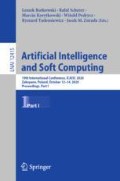Abstract
In the present contribution we investigate the mathematical model of the trade-off between optimum classification and reject option. The model provides a threshold value in dependence of classification, rejection and error costs. The model is extended to the case that the training data are affected by label noise. We consider the respective mathematical model and show that the optimum threshold value does not depend on the presence/absence of label noise. We explain how this knowledge could be used for probabilistic classifiers in machine learning.
All authors contributed equally.
Access this chapter
Tax calculation will be finalised at checkout
Purchases are for personal use only
Notes
- 1.
The generalization to class-wise correct classification costs is obvious.
References
Fawcett, T.: An introduction to ROC analysis. Pattern Recogn. Lett. 27, 861–874 (2006)
Pastor-Pellicer, J., Zamora-Martínez, F., España-Boquera, S., Castro-Bleda, M.J.: F-measure as the error function to train neural networks. In: Rojas, I., Joya, G., Gabestany, J. (eds.) IWANN 2013. LNCS, vol. 7902, pp. 376–384. Springer, Heidelberg (2013). https://doi.org/10.1007/978-3-642-38679-4_37
Herbei, R., Wegkamp, M.H.: Classification with reject option. Can. J. Stat. 34(4), 709–721 (2006)
Chow, C.K.: On optimum recognition error and reject tradeoff. IEEE Trans. Inf. Theory 16(1), 41–46 (1970)
Hansen, L.K., Liisberg, C., Salamon, P.: The error-reject tradeoff. Open. Syst. Inf. Dyn. 4, 159–184 (1997)
Pillai, I., Fumera, G., Roli, F.: Multi-label classification with a reject option. Pattern Recogn. 46, 2256–2266 (2013)
Bartlett, P.L., Wegkamp, M.H.: Classification with a reject option using a hinge loss. J. Mach. Learn. Res. 9, 1823–1840 (2008)
Yuan, M., Wegkamp, M.H.: Classification methods with reject option based on convex risk minimization. J. Mach. Learn. Res. 11, 111–130 (2010)
Villmann, T., et al.: Self-adjusting reject options in prototype based classification. In: Merényi, E., Mendenhall, M.J., O’Driscoll, P. (eds.) Advances in Self-Organizing Maps and Learning Vector Quantization. AISC, vol. 428, pp. 269–279. Springer, Cham (2016). https://doi.org/10.1007/978-3-319-28518-4_24
Frénay, B., Verleysen, M.: Classification in the presence of label noise: a survey. IEEE Trans. Neural Netw. Learn. Syst. 25(5), 845–869 (2014)
Villmann, A., Kaden, M., Saralajew, S., Hermann, W., Biehl, M., Villmann, T.: Reliable patient classification in case of uncertain class labels using a cross-entropy approach. In: Verleysen, M. (ed.) Proceedings of the 26th European Symposium on Artificial Neural Networks, Computational Intelligence and Machine Learning (ESANN 2018), Bruges, Belgium, pp.153–158. i6doc.com, Louvain-La-Neuve (2018)
Kullback, S., Leibler, R.A.: On information and sufficiency. Ann. Math. Stat. 22, 79–86 (1951)
Rényi, A.: On measures of entropy and information. In: Proceedings of the Fourth Berkeley Symposium on Mathematical Statistics and Probability, Berkeley. University of California Press (1961)
Cichocki, A., Amari, S.-I.: Families of alpha- beta- and gamma- divergences: flexible and robust measures of similarities. Entropy 12, 1532–1568 (2010)
Villmann, T., Cichocki, A., Principe, J.: Information theory related learning. In: Verleysen, M. (ed.) Proceedings of European Symposium on Artificial Neural Networks (ESANN 2011), pp. 1–10. i6doc.com, Louvain-La-Neuve (2011)
Goodfellow, I., Bengio, Y., Courville, A.: Deep Learning. MIT Press, Cambridge (2016)
Zeng, J., Ustun, B., Rudin, C.: Interpretable classification models for recidivism prediction. J. R. Stat. Soc. Ser. A. 180, 1–34 (2017)
Rudin, C.: Stop explaining black box machine learning models for high stakes decisions and use interpretable models instead. Nat. Mach. Intell. 1(5), 206–215 (2019)
Villmann, T., Saralajew, S., Villmann, A., Kaden, M.: Learning vector quantization methods for interpretable classification learning and multilayer networks. In: Sabourin, C., Merelo, J.J., Barranco, A.L., Madani, K., Warwick, K. (eds.) Proceedings of the 10th International Joint Conference on Computational Intelligence (IJCCI), Sevilla, pp. 15–21. SCITEPRESS - Science and Technology Publications, Lda, Lissabon (2018). ISBN 978-989-758-327-8
Biehl, M., Hammer, B., Villmann, T.: Prototype-based models in machine learning. Wiley Interdiscip. Rev. Cogn. Sci. 2, 92–111 (2016)
Kaden, M., Lange, M., Nebel, D., Riedel, M., Geweniger, T., Villmann, T.: Aspects in classification learning - review of recent developments in Learning Vector Quantization. Found. Comput. Decis. Sci. 39(2), 79–105 (2014)
Kohonen, T.: Self-Organizing Maps. SSINF, vol. 30. Springer, Heidelberg (1995). https://doi.org/10.1007/978-3-642-97610-0
Villmann, T., Bohnsack, A., Kaden, M.: Can learning vector quantization be an alternative to SVM and deep learning? J. Artif. Intell. Soft Comput. Res. 7(1), 65–81 (2017)
Sato, A., Yamada, K.: Generalized learning vector quantization. In: Touretzky, D.S., Mozer, M.C., Hasselmo, M.E. (eds.) Advances in Neural Information Processing Systems 8. Proceedings of the 1995 Conference, pp. 423–429. MIT Press, Cambridge (1996)
Seo, S., Obermayer, K.: Soft learning vector quantization. Neural Comput. 15, 1589–1604 (2003)
Villmann, A., Kaden, M., Saralajew, S., Villmann, T.: Probabilistic learning vector quantization with cross-entropy for probabilistic class assignments in classification learning. In: Rutkowski, L., Scherer, R., Korytkowski, M., Pedrycz, W., Tadeusiewicz, R., Zurada, J.M. (eds.) ICAISC 2018. LNCS (LNAI), vol. 10841, pp. 724–735. Springer, Cham (2018). https://doi.org/10.1007/978-3-319-91253-0_67
Saralajew, S., Holdijk, L., Rees, M., Asan, E., Villmann, T.: Classification-by-components: probabilistic modeling of reasoning over a set of components. In: Proceedings of the 31st Conference on Neural Information Processing Systems (NeurIPS 2019), pp. 2788–2799. MIT Press (2019)
Biederman, I.: Recognition-by-components: a theory of human image understanding. Psychol. Rev. 94(2), 115–147 (1987)
Acknowledgement
M. Mohannazadeh Bakhtiari is supported by a PhD-grant of the European Social Fund (ESF). S. Musavishavazi is supported by an ESF-project-grant supporting local cooperations between industry and universities for innovative research developments.
Author information
Authors and Affiliations
Corresponding author
Editor information
Editors and Affiliations
Rights and permissions
Copyright information
© 2020 Springer Nature Switzerland AG
About this paper
Cite this paper
Musavishavazi, S., Mohannazadeh Bakhtiari, M., Villmann, T. (2020). A Mathematical Model for Optimum Error-Reject Trade-Off for Learning of Secure Classification Models in the Presence of Label Noise During Training. In: Rutkowski, L., Scherer, R., Korytkowski, M., Pedrycz, W., Tadeusiewicz, R., Zurada, J.M. (eds) Artificial Intelligence and Soft Computing. ICAISC 2020. Lecture Notes in Computer Science(), vol 12415. Springer, Cham. https://doi.org/10.1007/978-3-030-61401-0_51
Download citation
DOI: https://doi.org/10.1007/978-3-030-61401-0_51
Published:
Publisher Name: Springer, Cham
Print ISBN: 978-3-030-61400-3
Online ISBN: 978-3-030-61401-0
eBook Packages: Computer ScienceComputer Science (R0)

